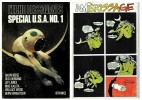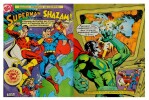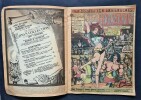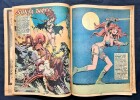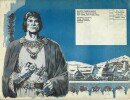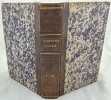298 books for « giordano »Edit
-
Type
Book (294)
Music sheets (4)
-
Language
English (1)
French (293)
Italian (4)
-
Century
16th (1)
19th (5)
20th (123)
21st (58)
-
Countries
Belgium (8)
Côte d'Ivoire (1)
Denmark (2)
France (235)
Italy (6)
Netherlands (3)
Switzerland (41)
United Kingdom (2)
-
Syndicate
CLAM (1)
ILAB (123)
NVVA (3)
SLACES (3)
SLAM (114)
Topics
- Actors (2)
- Agriculture (2)
- Alps (3)
- Arboriculture (7)
- Architecture (3)
- Biography (2)
- Botany (7)
- Buffon (1)
- Bulgaria (1)
- Cap (1)
- Children’s books (5)
- Christianity (2)
- Cinema (2)
- Comic strip (14)
- Cooking (2)
- Costumes (1)
- Couple (1)
- Creole (1)
- Cuba (1)
- Culinary art (2)
- Customs (1)
- Dance & ballet (1)
- Dictionaries (2)
- English (3)
- Essays (2)
- Ethic (1)
- Ethnology (6)
- First edition (8)
- Flora (1)
- Flowers (3)
- Franco (4)
- Galland (1)
- Geography (1)
- Germanic languages (3)
- Guide books (1)
- Helvética (5)
- Hermeticism (2)
- History (6)
- Horticulture (2)
- Illustrated books (1)
- Italian (11)
- Italy (11)
- Leisure (4)
- Lempereur (1)
- Literature (27)
- Lorenzo (1)
- Monaco (1)
- Mountaineering climbing (3)
- Music (1)
- Opera ballet (2)
- Painting (1)
- Palermo (2)
- Palestine (1)
- Philology (2)
- Philosophy (16)
- Photography (2)
- Physics (1)
- Physics pc (1)
- Piano (1)
- Policy (2)
- Prayers (1)
- Psychology (1)
- Regionalism (3)
- Religions (4)
- Reverend (2)
- Reviews (2)
- River (1)
- Rooster (1)
- Roses (1)
- Russia (1)
- Saul (3)
- Sciences (3)
- Scores (12)
- Sicily (3)
- Songs (4)
- Switzerland (4)
- Symbolism (2)
- Theatre (2)
- Theology (2)
- Travel (2)
- Turner (1)
- Vegetable garden (2)
- Velasquez (1)
- War (1)
- Youth (3)
( Bandes Dessinées ) - Ferdish Bharucha - Jeff Jones - Ralph Reese - Dick Giordano - Wallace Wood - Berni Wrightson - Mike Kaluta - Collectif.
Reference : 32269
Revue L'Echo des Savanes, Spécial U.S.A n° 1.
Editions du Fromage / Revue trimestrielle, L'Echo des Savanes, " Spécial U.S.A " n° 1 de 1976. In-4 agrafé de 74 pages au format 27 x 19 cm. Couvertures en couleurs illustrées par Jeff Jones. Plats et intérieur frais. Revue dirigée par Ferdish Bharucha avec l'aide de Yves Frémion. Bandes dessinées en noir de Jeff Jones, Ralph Reese, Dick Giordano, Wallace Wood, Berni Wrightson et Mike Kaluta. Fiche sur les artistes avec portrait photo au verso de la couverture. Rare édition originale, surtout dans un tel état général de fraicheur.
Vente exclusivement par correspondance. Le libraire ne reçoit, exceptionnellement que sur rendez-vous. Il est préférable de téléphoner avant tout déplacement.Forfait de port pour un livre 8,50 €, sauf si épaisseur supérieure à 3 cm ou valeur supérieure ou égale à 100 €, dans ce cas expédition obligatoire au tarif Colissimo en vigueur. A partir de 2 livres envoi en colissimo obligatoire. Port à la charge de l'acheteur pour le reste du monde.Les Chèques ne sont plus acceptés.Pour destinations extra-planétaire s'adresser à la NASA.Membre du Syndicat Lusitanien Amateurs Morues
( Bandes Dessinées ) - Rich Buckler - Dick Giordano - Gerry Conway.
Reference : 21807
(1980)
Superman contre Shazam !. L'Homme de Krypton aux prises avec le Capitaine Marvel en un combat titanesque.
Editions Sagedition / Collection " Présence de l'Avenir " - Spécial Collectionneurs 1980. Grand in-4 broché de 74 pages au format 33,5 x 25,5 cm. Couvertures illustrées. Dos carré muet avec infimes frottis. Plats et intérieur frais. Couverture et dessins de Rich Buckler de Dick Giordano sur scénario de Gerry Conway. Rare édition originale de cette BD très fragile, surtout dans un tel état de fraicheur, proche du parfait.
Vente exclusivement par correspondance. Le libraire ne reçoit, exceptionnellement que sur rendez-vous. Il est préférable de téléphoner avant tout déplacement.Forfait de port pour un livre 8,50 €, sauf si épaisseur supérieure à 3 cm ou valeur supérieure ou égale à 100 €, dans ce cas expédition obligatoire au tarif Colissimo en vigueur. A partir de 2 livres envoi en colissimo obligatoire. Port à la charge de l'acheteur pour le reste du monde.Les Chèques ne sont plus acceptés.Pour destinations extra-planétaire s'adresser à la NASA.Membre du Syndicat Lusitanien Amateurs Morues
( Bandes Dessinées - Conan - Robert Erwin Howard ) - Stan Lee - Roy Thomas - Barry Smith - Gil Kane - Neal Adams - Frank Thorne - Esteban Maroto - Dick Giordano - John Buscema - Alfredo Alcala - Ernie Chan.
Reference : 22245
(1977)
Spécial Collector's Issue ! Conan the Barbarian. The Cimmerian's greatest adventures co-starring, Red Sonja, she-devils with a sword.
Editions Marvel Comics Group / Marvel Treasury Spécial " Conan the Barbarian " 1977. In-4 broché, agrafé, de 80 pages au format 34 x 25,5 cm. Couvertures illustrées. Dos carré avec titre. Plats avec petits frottis et tassements aux coins. Intérieur frais, malgré un papier de piètre qualité. Contient 3 histoires, scénarisées par Roy Thomas. 1 : The song of Red Sonja illustrée en couleurs par Barry Smith - 2 : Night of Dark God illustrée en couleurs par Gil Kane et Neal Adams - 3 : Black Colossus illustrée en couleurs par John Buscema et Alfredo Alcala. En milieu de BD on trouve un portfolio consacré à Red Sonja avec illustrions en couleurs de dossier de Frank Thorne, Esteban Maroto et Dick Giordano. Au verso du 4ème plat, qui est un peu bruni, on trouve une carte de l'ère Hyborienne. Rarissime et mythique bande dessinée en bel état général.
Vente exclusivement par correspondance. Le libraire ne reçoit, exceptionnellement que sur rendez-vous. Il est préférable de téléphoner avant tout déplacement.Forfait de port pour un livre 8,50 €, sauf si épaisseur supérieure à 3 cm ou valeur supérieure ou égale à 100 €, dans ce cas expédition obligatoire au tarif Colissimo en vigueur. A partir de 2 livres envoi en colissimo obligatoire. Port à la charge de l'acheteur pour le reste du monde.Les Chèques ne sont plus acceptés.Pour destinations extra-planétaire s'adresser à la NASA.Membre du Syndicat Lusitanien Amateurs Morues
( Bandes Dessinées - Robert Erwin Howard - Conan ) - Chris Claremont - Stan Lee - Archie Goodwin - John Buscema - Ralph Maccio - Dick Giordano - Barry Windsor Smith - Frank Thorne - Roy Thomas - Skip Kirkland - Naomi Basner - Howard Zimmerman - Archie Goodwin - Roger Stern - John Severin - Collectif.
Reference : 22995
Magazine Foom ( Friends of Old Marvel ) n° 14 : Spécial Conan.
New York: Marvel Comics, Magazine Foom ( Friends of Old Marvel ) n° 14 de 1976. In-8 agrafé de 32 pages au format 27,5 x 21 cm. Couvertures illustrées en couleurs par John Buscema et John Severin. Numéro spécial entiérement consacré à Robert Erwin Howard, Conan, Red Sonja et Kull le roi Barbares, avec articles, interviews, bibliographies par Chris Claremont, Stan Lee, Archie Goodwin, Ralph Maccio, Roy Thomas, Skip Kirkland, Naomi Basner, Howard Zimmerman et Roger Stern, accompagnés d'illustrations en noir par John Buscema, Barry Windsor Smith - Dick Giordano, Frank Thorne, etc. Rarissime édition originale américaine, en très bel état général de fraicheur.
Vente exclusivement par correspondance. Le libraire ne reçoit, exceptionnellement que sur rendez-vous. Il est préférable de téléphoner avant tout déplacement.Forfait de port pour un livre 8,50 €, sauf si épaisseur supérieure à 3 cm ou valeur supérieure ou égale à 100 €, dans ce cas expédition obligatoire au tarif Colissimo en vigueur. A partir de 2 livres envoi en colissimo obligatoire. Port à la charge de l'acheteur pour le reste du monde.Les Chèques ne sont plus acceptés.Pour destinations extra-planétaire s'adresser à la NASA.Membre du Syndicat Lusitanien Amateurs Morues
Martine le destin ou la vie
Editions Grasset, Paris, 2011. In-8, broché sous couverture illustrée en couleurs, 170 pp. Introduction - 1. Martine Aubry aime-t-elle la politique? - 2. La fille de sa mère - 3. La sœur de son frère - 4. L'aubrysme existe-t-il? - 5. Martine Aubry a-t-elle un avenir? - Conclusion - Table des matières.
--- Plus d'informations sur le site archivesdunord.com
Phone number : 01 42 73 13 41
Opera ea quae ad adinventam ab ipso ertem universalem, Scientiarum Artiumque omnium breui compendio, firmaque memoria apprehendendarum, locupletissimaque vel oratione ex tempore pertractandarum, pertinent. Ut et In eandem quorumdam interpretum scripti... - [SPARKING LEIBNIZ' DREAM OF A UNIVERSAL ALGEBRA]
Argentinae (i.e Strassburg], Lazarus Zetzner, 1598. 8vo. Very nice 19th century half calf with richly gilt spine. Some browning and spotting, but overall a nice copy. Many woodcut diagrams in the text. Woodcut printer's device to title-page. (24), 992, (32) pp.
Scarce first edition of this seminal publication, which is practically solely responsible for the spreading of both Lullism and Bruno's mnemonic theories in the 17th century. This publication constitutes the standard work on Lull for more than a century and it directly influenced the most significant thinkers of the following century, e.g. Leibnitz, whose dream of a universal algebra was stimulated by the reading of Lull (and Bruno) in the present publication.""In 1598, while the philosopher from Nola (i.e. Bruno) was in prison in Rome, Johann Heinrich Alsted together with the printer Lazarus Zetzner in Strasburg, published a great collection of the works by Raymond Lull and the most significant commentaries on Lullism, among them also some treatises by Bruno. Since then, Bruno's mnemonics was a basic component of all attempts made in the seventeenth century to set up a universal science on the basis of a theory of combinations interpreted in terms of Neo-Platonism... It was also Leibniz who was one of the first to assume similarities between Bruno's theory of the infinite and the Cartesian theory of vortices in an undetermined and infinite universe"" Leibniz had had the opportunity to read these treatises in his capacity as librarian of the Herzog August Library in Wolfenbüttel"". (Blum, p. 110). ""From another of Pierce's Lists we know that he possessed an important collection of Lullian and Lullist texts, namely the Renaissance edition by the famous Strasbourg editor Lazarus Zetzner: ""Raymundi Lulli Opera ea quae ad adinventam ab ipso Artem universalem... pertinent"" (printed first in 1598, then 1609, 1617 and, by his heirs, in 1651). This edition, which was very influential - the young Leibniz, for instance, acquainted himself with Llull through this anthology-, contains several works by Llull himself as well as those Renaissance commentaries on his works by Agrippa of Netteshein, Giordano Bruno..."" (Fidora, p. 181).This highly influential publication of Lull's ""Opera"" through which Leibniz and many of his contemporaries got acquainted with Lull and Bruno, contains seven genuine works by Lull (including the two most important works of the last period of the Art, the ""Ars brevis"" and the ""Ars magna""), four works falsely attributed to Lull, Agrippa's ""In Artem Brevem"" - and Bruno's four highly important commentaries on Lull, being the ""De Lulliano specierum scrutinio"" (pp. 685-97), ""De Lampade combinatoria Lulliana"" (pp. 698-755), ""De Progressu Logicae venationis"" (pp. 756-62) and ""De Lampade venatoria logicurum"" (pp. 763-806), which constitute Bruno's most important logical treatises and his seminal writings on mnemonics. The four treatises originally appeared separately in 1587 and 1588 respectively, and all appear here for the second time (apart from the ""De progressu"", which also appeared together with the first printing of the ""De Lampade venatoria logicorum"" the following year and here thus appears for the third time). The first printings of these works are of impossible scarcity and hardly obtainable. These four groundbreaking works appear together for the first time in the present publication and it is through this second printing of them that 17th century thinkers such as Leibniz got acquainted with them. Raymond Lull (ca. 1232-1315) was one of the most important and influential philosophers and logicians of his time. He is considered a pioneer of several fields of science, now most notably computation theory. His works sparked Leibniz' interest in the field and drove him to his seminal invention. Lull invented an ""art of finding truth"" (often in Lullism referred to as ""The Art""), which centuries later, when read in the present publication, stimulated Leibnitz' dream of a universal algebra. Lull applied this art to basically all subjects studied at the Medieval Universities. ""Lull's metaphysics worked a revolution in the history of philosophy"" (The Cambridge History of Renaissance Philosophy, p. 548). Giordano Bruno (1548-1600) is one of the most significant thinkers of modern times. He prepared the way for the rise of modern philosophy and became a forerunner of modern philosophy and science. His logical commentaries and mnemonic treatises were of special importance to the emerging logic of the 17th century and it is his version of Lullism that comes to dominate this significant strand of thought for more than a century. Having been arrested in 1592 due to alleged heresy, Bruno was subjected to a 6 year long trial that finally condemned him to hanging in 1600, two years after the publication of the four works that came to secure his influence over the following century. ""Bruno burned for philosophy"" he was killed for moral, physical, and metaphysical views that terrified and angered authorities."" (Copenhaver & Schmitt, p. 315).""By far the greatest figure of this generation was Giordano Bruno (1548-1600), whose interest in Llull dates almost exclusively from his sojurns in France and Germany. His activities in this field, which he combined with his other aspects of Reniassance philosophy, are too complex to be treated in any detail here. Suffice it to say with Frances Yates that ""the three strands of the Hermetism, the mnemonics, the Lullism are all interwoven in Bruno's complex personality, mind and mission""...""Perhaps the most important event of Lulliasm of this period was not the appearance of any new figure or work but the publication of an anthology by Lazarus Zetzner of Strasburg, entitled ""Raymundi Lullii, opera ea quae ad adinventam ab ipso Artem universalem"", which, for the next century or so, was to become the standard work on Llull. It is therefore instructive in understanding seventeenth-century Lullism... The first edition of this anthology appeared in Strasburg in 1598. It was reprinted in 1609... reprinted in 1617 and again in 1651... This mixture of Llull, pseudo-Llull, and Renaissance commentaries, emphasizing a general art of discourse, constituted the ""package"" in which Llull was presented to seventeenth-century readers, including Leibniz (note 33: it was apparently the first edition of 1598 that Leibniz read), and it must be kept in mind when discussing their version of Llull."" (Bonner, pp. 67-68). Bruno's works, the first editions of which are all of the utmost scarcity, were generally not reprinted in Bruno's lifetime and new editions of them did not begin appearing until the 19th century. For three centuries his works had been hidden away in libraries, where only few people had access to them. One very significant exception is the four treatises that we find in the present publication. They are among the only of Bruno's treatises to be published again before the 19th century, and as they don't appear again on their own, but here, in THE most important publication of Lull's writings for more than a century, it is through this second printing of these four works that Bruno comes to have his primary influence upon 17th century philosophy and science. His separate publications were simply not accessible to thinkers like Leibniz and could thus not be studied. Also therefore, Zetzners' 1598 publication of Lull and Bruno together proved to be of seminal importance, not only to the spreading of Lullism, but just as much to the spreading of Bruno's even more important theories. ""Raymond Lull (ab. 1232 - 1315), Majorcan writer, philosopher, memorycian (he was later to become a great source of inspiration for Giordano Bruno), logician, and a Franciscan tertiary. He wrote the first major work of Catalan literature. Recently-surfaced manuscripts show him to have anticipated by several centuries prominent work on elections theory. He is sometimes considered a pioneer of computation theory, especially given his influence on Gottfried Leibniz. He is also well known also as a glossator of Roman Law. Lull taught himself Arabic with the help from a slave. As a result, he wrote his ""Ars Magna"", which was intended to show the necessary reasons for the Christian faith. To promote his theory and test its effectiveness, he went to Algiers and Tunis. At the age of 82, in 1314, Lull traveled again to North Africa, where an angry crowd of Muslims stoned him in the city of Bougie. Genoese merchants took him back to Mallorca, where he died at home in Palma the following year."". (Thorndyke)Giordano Bruno was born in Nola in Southern Italy in 1548, and entered the Dominican order in Naples at the age of 18. While pursuing theological studies, he also thoroughly studied the ancient philosophers and began doubting some of the teachings of the Catholic Church. When he was in Rome in 1576, these doubts became known to the authorities of his order, and an indictment for heresy was prepared against him. Before he could be arrested, he escaped and began a long journey which took him to many European countries, among these England, where his most important works are published, until in 1592 he was denounced to the Inquisition and arrested. In 1593 he was taken to Rome, imprisoned, and subjected to a 6 year long trial. He firmly refused to recant his philosophical opinions, and in 1600 he was condemned for heresy, sentenced to death, and burned alive.SALVESTRINI NR. 1.See:Anthony Bonner: Doctor Illuminatus. A Ramon Llull Reader, 1993.Paul Richard Blum: Giordano Bruno. An Introduction, 2012.The Cambridge History of Renaissance Philosophy.Alexander Fidora: Peirce's Account of the Categories and Ramon Llull.
( Bandes Dessinées en Petits Formats ) - Stan Lee - Roy Thomas - George Tuska - Gil Kane - Gene Colan - Dick Giordano - John Romita.
Reference : 31919
(1970)
Le Journal des Super-Héros : Strange n° 68.
Editions Lug. Strange n° 68 du 5 août 1975. In-4 broché de 88 pages au format 24 x 17 cm. Belle couverture illustrée. Dos carré. Plats et intérieur frais malgré d'infimes frottis aux coins et 6 minuscules traits de stylo bleu en couverture. Contient les séries : Captain Marvel, Daredevil, Iron Fist, l'Araignée ( Spider-Man ). Scénarios de Stan Lee, Roy Thomas et Mike Friedrich avec dessins en couleurs par Gil Kane, Gene Colan, George Tuska et John Romita.. Rare édition originale, en superbe état général de fraicheur.
Vente exclusivement par correspondance. Le libraire ne reçoit, exceptionnellement que sur rendez-vous. Il est préférable de téléphoner avant tout déplacement.Forfait de port pour un livre 8,50 €, sauf si épaisseur supérieure à 3 cm ou valeur supérieure ou égale à 100 €, dans ce cas expédition obligatoire au tarif Colissimo en vigueur. A partir de 2 livres envoi en colissimo obligatoire. Port à la charge de l'acheteur pour le reste du monde.Les Chèques ne sont plus acceptés.Pour destinations extra-planétaire s'adresser à la NASA.Membre du Syndicat Lusitanien Amateurs Morues
( Batman ) - Denny O'Neil - Dick Giordano - Frank Robbins - Don Heck.
Reference : 29485
Collection Batman Géant n° 10 : Carnaval - Nuit Tragique - Les deux Perruques. ( Complet du rare poster, encarté au milieu du magazine ).
Editions Sagedition / Collection " Batman Géant ", trimestriel n° 10 de 1974. In-8 agrafé de 82 pages au format 24 x 17 cm. Couverture illustrée en couleurs. Plats et intérieur frais, malgré d'infimes frottis aux coins. Contient 3 aventures de Batman sur scénarios de Denny O'Neil et Frank Robbins avec dessins en noir et en couleurs par blanc Frank Robbins et Don Heck.En de revue on trouve une aventure de Superman, intitulée " L'Homme le plus dangereux " avec scénario de Cary Bates et dessins en noir et en couleurs de Curt Swan et Murphy Anderson. Rare édition originale en superbe état général, bien complète du rare poster en couleurs, encarté, en milieu de publication.
Vente exclusivement par correspondance. Le libraire ne reçoit, exceptionnellement que sur rendez-vous. Il est préférable de téléphoner avant tout déplacement.Forfait de port pour un livre 8,50 €, sauf si épaisseur supérieure à 3 cm ou valeur supérieure ou égale à 100 €, dans ce cas expédition obligatoire au tarif Colissimo en vigueur. A partir de 2 livres envoi en colissimo obligatoire. Port à la charge de l'acheteur pour le reste du monde.Les Chèques ne sont plus acceptés.Pour destinations extra-planétaire s'adresser à la NASA.Membre du Syndicat Lusitanien Amateurs Morues
ANDREA CHENIER DRAMMA DI AMBIENTE STORICO SCRITTO IN QUATTRO QUADRI DA LUIGI ILLICA E MUSICATO DA UMBERTO GIORDANO
MILANO EDOARDO SONZOGNO EDITORE
In 8. Dim. 19,5x13,5 cm. Pp. 72. Bel libretto d'opera degli anni '30 dell'opera lirica in quattro atti "Andrea Chenier" di Umberto Giordano (1867-1948) su libretto di Luigi Illica (1857-1919) ispirata alla vita del poeta francese Andrè Chenier (1762-1794). Senza data ma della fine del XIX secolo. La prima rappresentazione ebbe luogo al Teatro la Scala di Milano il 28 Marzo 1896 <BR>In buone condizioni. Bella brossura editoriale illustrata. Brossura editoriale in buone condizioni generali con lievi usure e strappi ai margini e dorso. Legatura in discrete condizioni. All'interno le pagine si presentano in buone condizioni con rare fioriture. Beautiful booklet of 1930's of the work in four acts "Andrea Chenier" by Umberto Giordano (1867-1948) on booklet by Luigi Illica (1857-1919) inspired to the real life of the french poet Andrè Chenier (1762-1794). <BR>The first representation took place in the Teatro La Scala in Milan the 28th of March 1896. <BR>Not dated but of the end of XIX century. In good conditions. Illustrated editorial cover. Editorial cover in good general conditions slightly worn in the edges and spine. Binding in fair conditions. Inside pages are in good conditions with occasional foxings.
FEDORA MUSICA DI UMBERTO GIORDANO
MILANO CASA MUSICALE SONZOGNO
In 4. Dim. 34x25 cm. Pp. 3. Edizione dei primi del '900 della melodia "Arioso di Loris "Amor ti vieta"" tratto da "Fedora" opera lirica di Umberto Giordano (1867-1948). Opera per tenore con accompagnamento di pianoforte. In discrete condizioni. Copertina editoriale in mediocri condizioni generali con usure e parti mancanti ai margini e dorso. Legatura in mediocri condizioni con rotture. All'interno le pagine si presentano in buone condizioni con fioriture ed usure. Edition of the first years of 1900 of the melody "Arioso di Loris "Amor ti vieta"" taken from "Fedora" lyric work of Umberto Giordano (1867-1948). Work for tenore In fair conditions. Editorial cover in poor general conditions with wearings and missing parts in the edges and spine. Binding in poor conditions with cracks. Inside pages are in fair conditions with foxings and wearings.
The cosmology of Giordano Bruno.
Ithaca, New York, etc., Cornell University Press, 1973.
306 p. Cloth. 21.5 cm (Original title 'La cosmologie de Giordano Bruno', Paris 1962)
TRATTATO ELEMENTARE DI FISICA SPERIMENTALE E DI FISICA TERRESTRE
NAPOLI STAMPERIA DELLA REGIA UNIVERSITA 1867
Edizione del 1867 di questa opera di fisica di G. Giordano. L'opera è composta da due tomi legati insieme ed è completa. Alcune incisioni nel testo che mostrano strumenti ed esperimenti di fisica. All'interno: Fisica delgi antichi, Cenno di meccanica, Gravità, Attrazione molecolare e stato solido, Stato liquido, Stato aeriforme, Acustica, Calore, Magnetismo, Elettricità statica, Elettrodinamica, Ottica, Fisica terrestre ecc... In ottime condizioni. Copertina in mezza pelle coeva con titolo e decorazioni in oro al dorso in ottime condizioni generali con lievi usure ai margini e dorso. Legatura in buone condizioni. All'interno le pagine si presentano in buone condizioni con fioriture. Occhietto del primo tomo mancante. In 8. Dim. 22x15 cm. Pp. XVI+432+455+(1).Edition of 1867 of this work of physics by G. Giordano. the work is amde up of two tomes bound together and it is complete. Dome engravings in the text showing instruments and experiments of physics ed esperimenti di fisica. In very good conditions. Half leather coeval cover with gilted title and decorations in the spine in very good general conditions lightly worn in the extremities. Binding in good conditions. Inside pages are in good conditions with foxing. False title of the first tome lacks. In 8. Dim. 22x15 cm. Pp. XVI+432+455+(1).
ANDREA CHENIER DRAMMA DI AMBIENTE STORICO IN QUATTRO QUADRI DI LUIGI ILLICA
MILANO CASA MUSICALE SONZOGNO 1896
Spartito musicale del 1896 dell'opera lirica in quattro atti "Andrea Chenier" di Umberto Giordano (1867-1948) su libretto di Luigi Illica (1857-1919) ispirata alla vita del poeta francese Andrè Chenier (1762-1794). La prima rappresentazione ebbe luogo al Teatro la Scala di Milano il 28 Marzo 1896. Trascrizione facile per pianoforte di Gellio Benvenuto Coronaro. In buone condizioni. Brossura editoriale in ottime condizioni generali con lievi usure e strappi ai margini e dorso. Legatura editorialmente assente. All'interno le pagine si presentano in buone condizioni con rare fioriture. In 4. Dim. 33x25 cm. Pp. 10.musical score of 1896 of the work in four acts "Andrea Chenier" by Umberto Giordano (1867-1948) on booklet by Luigi Illica (1857-1919) inspired to the real life of the french poet Andrè Chenier (1762-1794). The first representation took place in the Teatro La Scala in Milan the 28th of March 1896. Easy transcription for piano by Gellio Benvenuto Coronaro. In good conditions. Illustrated editorial cover. Editorial cover in good general conditions slightly worn in the edges and spine. Binding editoriarly missing. Inside pages are in good conditions with occasional foxings. In 4. Dim. 33x25 cm. Pp. 10.
Suis les chemins des animaux - Dès 18 mois
Lito 2020 10 pages 22 8x22 8x1 2cm. 2020. board_book. 10 pages.
Très bon état
Suis les chemins des bébés animaux - Dès 18 mois
Lito 2020 10 pages 22 8x22 8x1 2cm. 2020. board_book. 10 pages.
Très Bon Etat
Suis les chemins des bébés animaux - Dès 18 mois
Lito 2020 10 pages 22 8x22 8x1 2cm. 2020. board_book. 10 pages.
Très bon état
Singular Beauty: Simple Microscopes from the Giordano Collection. Catalogue of an Exhibition at the MIT Museum September 1st 2006 to June 30th 2007.
2006 64 p., 127 coloured photographs, frontispiece, paperbound.There are three introductory essays: Curator s Introduction by Deborah G. Douglas; Collector s Introduction by Raymond V. Giordano; Simple Microscopes by Anthony Turner.
ANDREA CHENIER DRAMMA DI AMBIENTE STORICO SCRITTO IN QUATTRO QUADRI DI LUIGI ILLICA
MILANO CASA MUSICALE SONZOGNO 1930
Libretto musicale del 1930 dell'opera lirica in quattro atti "Andrea Chenier" di Umberto Giordano (1867-1948) su libretto di Luigi Illica (1857-1919) ispirata alla vita del poeta francese Andrè Chenier (1762-1794).<BR>La prima rappresentazione ebbe luogo al Teatro la Scala di Milano il 28 Marzo 1896.<BR>In buone condizioni. <BR>Brossura editoriale in buone condizioni generali con lievi usure ai margini e dorso, fioriture. Segni di penna al piatto posteriore. Legatura in buone condizioni. Pagine in buone condizioni con rare fioriture. In 16. Dim. 18,5x13,5 cm. Pp. 71.
FEDORA DRAMMA DI V. SARDOU RIDOTTO IN TRE ATTI PER LA SCENA LIRICA DA ARTURO COLAUTTI
MILANO CASA MUSICALE SONZOGNO
Edizione degli anni '30 del libretto d'opera Fedora di Umberto Giordano. L'opera venne rappresentata per la prima volta il 17 novembre 1898 al Teatro Civico di Milano. Nella lista dei personaggi tre attori manoscritti dal vecchio proprietario. Parte inferiore del frontespizio mancante. In discrete condizioni. Copertina editoriale in discrete condizioni generali con lievi usure ai margini e dorso. Legatura in buone condizioni. All'interno le pagine si presentano in ottime condizioni con rare fioriture. In 16. Dim. 18,5x13,5 cm. Pp. 72.
La splendeur de monreale [Paperback] Stefano Giordano
BROCHE TRES BON ETAT
Merci de nous contacter à l'avance si vous souhaitez consulter une référence dans notre boutique à Authon-du-Perche.
[Carlo Carra] - Mussa, Itala, Cecilia Casorati and Giovanni Giordano
Reference : 109545
(1987)
Carlo CarrÃ. L'Opera Grafica 1922-1964
Mussa, Itala, Cecilia Casorati and Giovanni Giordano: Carlo CarrÃ. L'Opera Grafica 1922-1964. Milan: Fabbri, 1987. 102 pages, illustrated in black and white. Paperback. 23 x 22cms. Text in Italian.
Text in Italian
[Filippo Thomas Marinetti] - Guerri, Giordano Bruno
Reference : 112404
(2009)
ISBN : 9788883453069
Futurismo: Filippo Tommaso Marinetti, l'avanguardia giuliana e i rapporti internazionali
Guerri, Giordano Bruno: Futurismo: Filippo Tommaso Marinetti, l'avanguardia giuliana e i rapporti internazionali. Exhibition: Gorizia, Fondazione Cassa di Risparmio, 2009. 414 pages, colour illustrations. Paperback. 28cms. Catalogue of an exhibition held at Sala della Fondazione, Cassa di risparmio di Gorizia, Gorizia, Italy, Nov. 28, 2009-Feb. 28, 2010. Text in Italian.
Catalogue of an exhibition held at Sala della Fondazione, Cassa di risparmio di Gorizia, Gorizia, Italy, Nov. 28, 2009-Feb. 28, 2010. Text in Italian
La solitude des nombres premiers
2009 Paris, seuil, 2009, 14x20.5cm, 330pp Etat neuf car service de presse
.
 Write to the booksellers
Write to the booksellers